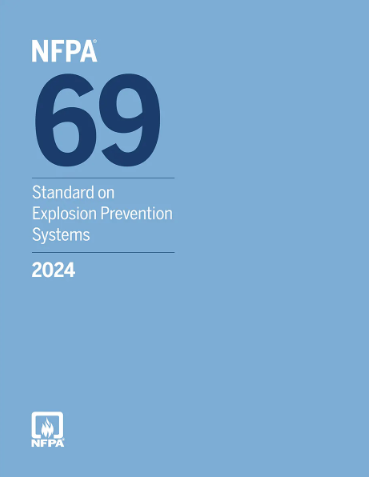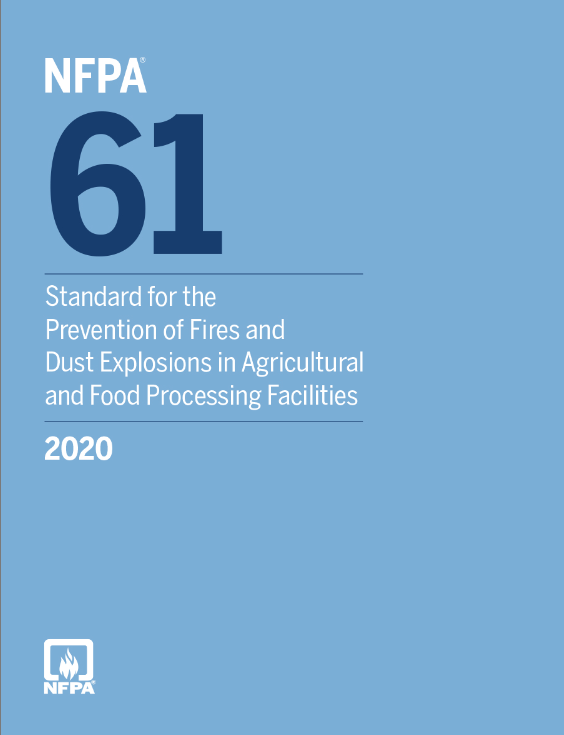Published March 20, 2025 Authored by Dr. Chris Cloney and Jon Barrett of Dust Safety Science
Explore how this standard provides comprehensive guidelines for preventing explosions in enclosures with flammable concentrations of gases, dust, or hybrid materials.

What is the NFPA 69 Standard?
The National Fire Protection Association, NFPA 69, Standard on Explosion Prevention Systems, provides guidance to prevent explosions due to combustible dust particles, gases, or vapors. The NFPA 69 Standard also protects pipes, ductwork, and dust collection systems. It covers explosion prevention, explosion isolation, oxidant concentration control, fuel concentration control, and ignition control systems, and provides requirements for designers, safety officers, and facility managers that are vital to help prevent dust and spark explosions in woodworking, grain processing, machining, and other facilities.
Combustible dust refers to fine particles suspended in the air, capable of igniting under certain conditions, leading to fires or explosions. When these particles accumulate in sufficient quantities and encounter an ignition source, the resulting conflagration can be devastating. These airborne particles can ignite with a spark or flame, leading to combustion and potentially causing a fire or explosion. Other materials and products, such as grain dust, flour, paper, wood, metal, coal, plastic, cotton, and rubber that may combust in powdered form are extensive and include a wide range of materials. Some materials, such as zinc or potatoes are not combustible in larger pieces but can be when pulverized to fine dust. The US Occupational Safety and Health Administration (OSHA) maintains a comprehensive list of combustible materials.
NFPA 69 details the implementation of safety instrumented systems to avoid dust explosions in industrial workplaces. It highlights reducing combustible concentrations, including consolidation of control panels and installing systems that manage and track possible hazards.
Key Takeaways:
- NFPA 69 outlines different explosion prevention methods, such as the combustible concentration reduction method and explosion suppression.
- It underscores the importance of system design verification through testing and regular maintenance to keep explosion prevention systems functional.
- Industry-specific standards may precede despite general guidelines from NFPA 69. Industries working with combustible dust have their own standards.
Have questions about combustible dust? Get expert advice here.
TABLE OF CONTENTS
Understanding Relevant Standards and Regulations
Other NFPA Standards
Understanding NFPA Standards
NFPA 61: Standard for the Prevention of Fires and Dust Explosions in Agricultural and Food Processing Facilities
NFPA 68: Standard on Explosion Protection by Deflagration Venting
NFPA 484: Standard for Combustible Metals
NFPA 499: Recommended Practice for the Classification of Combustible Dusts and of Hazardous (Classified) Locations for Electrical Installations in Chemical Process Areas
NFPA 652: Standard on the Fundamentals of Combustible Dust
NFPA 655: Standard for Prevention of Sulfur Fires and Explosions
NFPA 660: Standard Proposed
NFPA 664: Standard for the Prevention of Fires and Explosions in Wood Processing and Woodworking Facilities
Understanding Relevant Standards and Regulations
OSHA sets forth regulations related to grain handling facilities in the United States. These regulations, outlined in OSHA’s Grain Handling Facilities Standard (29 CFR 1910.272), cover requirements for:
- Housekeeping: Mandating regular cleaning to control dust accumulation.
- Grain Dryer Safety: Establishing guidelines for the safe operation of grain dryers.
- Preventative Maintenance: Requiring regular inspection and maintenance of equipment.
- Emergency Planning: Ensuring facilities have emergency action plans in place.
The National Fire Protection Association, NFPA, provides guidelines for the prevention of dust explosions in agricultural and industrial settings. NFPA 61: Standard for the Prevention of Fires and Dust Explosions in Agricultural and Food Processing Facilities, includes recommendations for:
- Dust Control: Implementing measures to minimize dust generation and accumulation.
- Ignition Source Control: Identifying and mitigating potential ignition sources.
- Explosion Protection: Installing explosion protection systems to mitigate the impact of explosions.
Other NFPA Standards
In the realm of industrial safety, adherence to standards is paramount. The NFPA stands as a beacon of guidance, offering a comprehensive framework through its myriad of standards. Among these, NFPA 61, NFPA 68, NFPA 69, NFPA 484, NFPA 499, NFPA 499, NFPA 652, NFPA 655, NFPA 660, and NFPA 664 hold significant importance, each delineating specific guidelines aimed at enhancing safety measures in various industrial environments. In this article, we delve into these standards, understanding their significance, implications, and the necessity of compliance.
Understanding NFPA Standards
The NFPA, a globally recognized organization, is dedicated to reducing the burden of fire and other hazards on the quality of life. It achieves this through the development and dissemination of codes and standards, training, research, and education. Among its extensive library of standards, those pertaining to industrial safety play a crucial role in safeguarding personnel, property, and the environment from the risks associated with industrial processes and combustible dust explosions. The many standards to understand include:
NFPA 61: Standard for the Prevention of Fires and Dust Explosions in Agricultural and Food Processing Facilities
Agricultural and food processing facilities face unique fire and explosion risks associated with organic materials and processing operations. NFPA 61 addresses these risks by outlining requirements for the design, construction, and operation of facilities involved in the processing, handling, and storage of agricultural and food products, with a focus on fire prevention and dust explosion mitigation.
NFPA 68: Standard on Explosion Protection by Deflagration Venting
NFPA 68 focuses specifically on deflagration venting, offering guidelines for the design, location, installation, maintenance, and inspection of systems intended to vent combustion gases and pressures resulting from deflagrations within enclosures. By facilitating the safe release of pressure, NFPA 68 mitigates the risk of structural damage and injuries caused by explosion events.
NFPA 69: Standard on Explosion Prevention Systems
NFPA 69 provides guidance on the installation, operation, and maintenance of systems for the prevention and mitigation of explosions in processes involving combustible dusts, gases, or vapors. It outlines measures such as explosion venting, suppression, and isolation to minimize the impact of potential explosions, thereby ensuring worker safety and facility integrity.
NFPA 484: Standard for Combustible Metals
NFPA 484 addresses the fire and explosion risks associated with combustible metals, providing guidance on the safe handling, processing, and storage of such materials. By outlining requirements for dust control, ventilation, equipment design, and emergency response, NFPA 484 helps mitigate the unique hazards posed by combustible metal powders and dust.
NFPA 499: Recommended Practice for the Classification of Combustible Dusts and of Hazardous (Classified) Locations for Electrical Installations in Chemical Process Areas
NFPA 499 provides guidance on the classification of combustible dust and hazardous locations within chemical process areas, ensuring compatibility between electrical equipment and the surrounding environment. By delineating hazardous area classifications and electrical installation requirements, NFPA 499 helps prevent ignition sources and mitigate the risk of fires and explosions in chemical processing facilities.
NFPA 652: Standard on the Fundamentals of Combustible Dust
NFPA 652 serves as the foundational standard for managing combustible dust hazards across various industries. It provides essential guidance on identifying, evaluating, and controlling combustible dust hazards, emphasizing the importance of comprehensive dust management strategies to mitigate the risk of dust-related fires and explosions.
Stay ahead of the regulations—sign up for expert-led combustible dust safety training.
NFPA 655: Standard for Prevention of Sulfur Fires and Explosions
The National Fire Protection Association, (NFPA) 655 standard, Standard for Prevention of Sulfur Fires and Explosions outlines requirements to reduce or eliminate hazards when handling and processing sulfur. The 2017 edition of the standard includes changes to definitions and other material that correlate with NFPA 654, Standard for the Prevention of Fire and Dust Explosions.
NFPA 660: Standard Proposed
Please note: NFPA 660 is in the Fall 2024 cycle due to the Combustible Dust Document Consolidation Plan (consolidation plan) as approved by the NFPA Standards Council. As part of the consolidation plan, NFPA 660 is combining Standards NFPA 61, NFPA 484, NFPA 652, NFPA 654, NFPA 655, and NFPA 664
NFPA 664: Standard for the Prevention of Fires and Explosions in Wood Processing and Woodworking Facilities
Due to the presence of combustible materials and processes, wood processing and woodworking facilities pose unique fire and explosion hazards. NFPA 664 addresses these risks by establishing requirements for the design, construction, operation, and maintenance of such facilities, encompassing aspects like dust collection, fire protection systems, and ignition source control.

Conclusion
In the landscape of industrial safety, adherence to NFPA standards is non-negotiable. Whether mitigating the risks of combustible dust, preventing explosions in wood processing facilities, or ensuring the safe handling of combustible metals, NFPA 61, NFPA 68, NFPA 69, NFPA 484, NFPA 499, NFPA 499, NFPA 652, NFPA 655, NFPA 660, and NFPA 664 standards provide a comprehensive framework for safeguarding lives, property, and the environment. By understanding and implementing The National Fire Protection Association standards industrial stakeholders can bolster their safety protocols, foster compliance, and ultimately create safer working environments for all.
Boost your safety knowledge and reduce risk—sign up now.
About Dust Safety Science
For more from Dr. Chris Cloney on Dust Collector Systems, visit this Podcast: NFPA 660 Development and Rollout Process with Laura Moreno

Combustible Dust Hazard Analysis
Resources:
Visit Dust Safety Science (Global Incident Tracking)
Visit Dust Safety Academy (Resources, Training, and Events)
Visit Dust Safety Professionals (Need Help? Get Support Today!)
Visit Dust Safety Journal for the Complimentary, Dust Safety Science Monthly Journal
Subscribe to our Complimentary, Dust Safety Science Newsletter at Dust Safety Science Newsletter
Visit the Dust Safety Science blog for written articles on combustible dust safety including the latest research, expert opinions, and state-of-the-art in fire and explosion protection.
